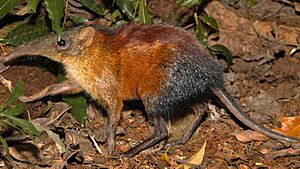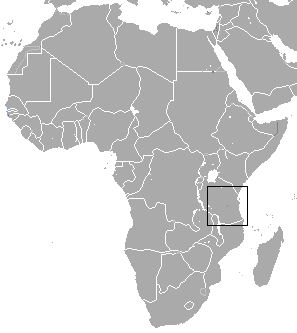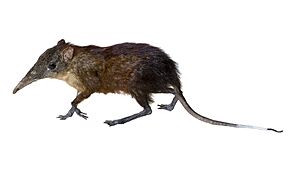Grey-faced sengi facts for kids
Quick facts for kids Grey-faced sengi |
|
|---|---|
 |
|
| Conservation status | |
| Scientific classification | |
| Genus: |
Rhynchocyon
|
| Species: |
udzungwensis
|
 |
|
| Grey-faced sengi range | |
The grey-faced sengi (Rhynchocyon udzungwensis) is a special type of elephant shrew. It lives only in the Udzungwa Mountains in south-central Tanzania, a country in Africa.
Scientists announced they had found this animal in January 2008. Before this, only 15 types of elephant shrews were known. The last new one was found over 120 years ago! This sengi gets its name from its unique grey face. It also has a black back end and is bigger than other elephant shrews.
Contents
What Does the Grey-faced Sengi Look Like?
This sengi has shiny, thin fur. Its face is grey, and its fur is a bright red color. It has a wide maroon stripe along its back. Its back legs are jet-black, and its belly and tail are light brown.
The grey-faced sengi is bigger than other sengis. It also has a longer upper tooth row. On average, this sengi is about 56.4 cm (22.2 in) long. It weighs about 711 g (25.1 oz). At 700 g (1.5 lb), it is about 25% larger than any other known sengi.
How Was the Grey-faced Sengi Discovered?
The grey-faced sengi is part of the elephant shrew family, also called sengis. It belongs to the group Rhynchocyon. Its discovery was announced in 2008. This was a very rare find for mammals, as the last new elephant shrew was found over a century ago.
This new sengi was found in the Ndundulu Forest in Tanzania's Udzungwa Mountains. This area is isolated and has many different kinds of plants and animals. Other new species found there include the Udzungwa partridge and a monkey called the kipunji.
The first time this new species was seen was in 2005. Francesco Rovero, a scientist from Italy, set up camera traps. These cameras took pictures of an unfamiliar elephant shrew. He sent the pictures to Galen Rathbun, another scientist.
Rathbun could not identify the shrew. So, he went on an expedition with Rovero in March 2006. They wanted to find some of these shrews. It rained a lot during their trip, even though it was supposed to be the dry season. They also found the animals were much bigger than expected. Their traps were too small! They had to use traditional twine snares instead.
Galen Rathbun said, "This is one of the most exciting discoveries of my career. It is the first new species of giant elephant-shrew to be discovered in more than 126 years. From the moment I first lifted one of the animals into our photography tent, I knew it must be a new species not just because of its distinct coloring, but because it was so heavy!"
Rathbun, Rovero, and other scientists wrote about their discovery in a science magazine called the Journal of Zoology. They gave the new species the scientific name Rhynchocyon udzungwensis. This means 'snouted dog from Udzungwa'. They called it the grey-faced sengi because of its grey face.
The first video of the grey-faced sengi was captured in 2007. Tim Balazs and John Lochow filmed it on Mount Nandango, Tanzania. This location is about 400 km from where Rathbun and Rovero found their specimens.
Where Does the Grey-faced Sengi Live?

The grey-faced sengi lives only in the Udzungwa Mountains in south-central Tanzania. It can be found in the Ndundulu-Lauhomero forests and the Mwanihana forests.
The Udzungwa Mountains are a series of isolated mountain ranges. They stretch from southern Kenya to south-central Tanzania. Because these mountains are so isolated, many unique species have developed there. These species cannot be found anywhere else in the world.
Only two groups of grey-faced sengis are known. They live in an area of about 300 square kilometres (120 sq mi) of forest. Their natural home is within two nature reserves: The Udzungwa Ecological Monitoring Centre and the Udzungwa Mountains National Park. The sengi's home is mostly moist, evergreen forests, including areas with bamboo plants.
Grey-faced Sengi Reproduction
Scientists believe there are about 15,000 to 24,000 grey-faced sengis. There are about 50 to 80 sengis in each square kilometer. There are roughly the same number of males and females.
This sengi builds nests from leaves and soil. They might build up to five nests in one tree. It is thought that they have one or two babies at a time.
What Threats Do Grey-faced Sengis Face?
The main threat to the grey-faced sengi is human activity. As human populations grow in Africa, especially in Tanzania, there is more pressure on the forests where these animals live. This can lead to their homes shrinking.
Another threat is forest fires started by humans. Since the sengi depends on its forest home, fires can harm them greatly. Because there are not many sengis, any damage to their habitat can affect the species a lot. Some people think local tribes might hunt them, but this has not been proven.
Efforts are being made to help save the grey-faced sengi. Local programs teach people about the importance of protecting the sengi's home. This can help reduce hunting and habitat damage.
The sengi's home is also inside two nature reserves. These parks help protect the sengis from hunters and growing human activity. The nature reserves do not allow hunting or destruction of the forest. This gives the grey-faced sengi extra protection.
These parks also help scientists who visit to study the animals. This gives the sengi a better chance to survive. The parks work to protect all species, not just one. They monitor animals, train park rangers, and teach students. They also share information with other conservation groups. However, a specific plan for the future protection of the grey-faced sengi has not yet been made.


